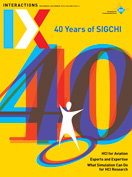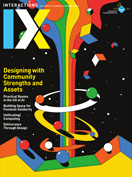Authors: Aaron Marcus
Posted: Tue, February 19, 2013 - 2:04:55
Since 1992 (at CHI 1992’s panel session at which I invited cyberpunk authors to talk about their ideas of the future), I have proposed that human-computer interaction (HCI) professionals would benefit from studying science fiction and its description of HCI and computer-mediated communication. In 1999, at the request of the ACM Special Interest Group on Computer-Human Interaction (SIGCHI)—because, their representative said, my earlier panel was one of the most popular events ever held at CHI—I repeated this panel as a plenary session at CHI 1999.
This study of science-fiction media seems especially valuable in the display of equipment and the ways people interact with many devices in science-fiction movies and television. I gave a keynote address on this topic at Mensch und Komputer 2011 (see the video). More recently, in 2012, I published a free, downloadable ebook on this topic, 100 Years of the Future: HCI in Science-Fiction Movies and Television (available here ). In 2012, I also pubished an article, “Back to the Future: UX in the Past 100 Years of Science Fiction,” in User Experience (11:3, 3rd Quarter 2012, pp. 30-31). In 2012, I was also privileged to present a tutorial about HCI in science-fiction movies and television at the APCHI 2012 confrence in Matsue, Japan, and a lecture about this topic at the UPA/User Friendly conference in Beijing, China.
I am pleased to announce that User Experience (UX) will publish a special issue about science-fiction co-edited by myself and Chris Koster (13:2, 2nd Quarter). We shall feature interviews by Rudy Rucker and Bruce Sterling, two well-known science-fiction authors, who also participated in the earlier CHI panels twenty years ago! I am also please to announce that my article about HCI and science fiction has been scheduled for the July + August issue of interactions.
In addition, I plan to give tutorials about “HCI/CHI/UX in Science-Fiction Movies and Television” at the CHI 2013 conference in Paris, France on May 1, 2013, and at the Design, User Experience, and Usability (DUXU) 2013 conference in Las Vegas on July 22, 2013. At the latter conference, I shall be publishing a paper about UX and science fiction in Chinese, Indian, and Japanese sci-fi movies.
Clearly, interest in this topic is gaining momentum, as witnessed by other books, papers, and articles. Professionals of many kinds are recognizing the value of conducting heuristic evaluations of equipment shown in sci-fi media, of conducting virtual ethnographic studies, of studying the personas and use scenarios expicitly or implicitly depicted, and cataloging the trends that these media portray or predict. This information will be useful to researchers, designers, analysts, and evaluators of all kinds.
One other direction that these studies lead to is looking at cross-cultural issues in HCI/CHI/UX as depicted in sci-fi movies and television. I address that topic in my ebook and in my On the Edge column in the forthcoming special issue of UX (13:2), as well as my forthcoming DUXU13 paper. I highlight some points here:
User-experience in science-fiction media, especially under the influence of Hollywood, inevitably sets up a bias toward Western media. One should not forget Asian sci-fi filmmakers who have been inspired by some of the classic Western sci-fi novels as well as their own literature traditions. They have produced films that reflect their unique cultural heritages, much like Bollywood films, which combine traditional storytelling with music and dance quite unlike most of the products of Hollywood.
The study of Chinese, Indian, and Japanese approaches to metaphors, mental models, navigation, interaction, and appearance will be worth much further study. Research studies may reveal cross-cultural influences of one genre upon the other. With the rise of multiple film production centers, it is possible that the influences may run in multiple directions in the decades ahead. To give you a sample of the material to study, I cite some of the films as excerpted from my ebook.
Chinese sci-fi films
Chinese sci-fi filmmaking seems to have started earlier than Indian. Jules Verne stories were imported into China during the late 19th and early 20th centuries. Yueqiu Zhimindi Xiaoshuo (Lunar Colony), 1904, seems to be the earliest original Chinese sci-fi writing. Zheng Wenguang, the father of modern Chinese science-fiction literature, wrote in the 1950s through the 1970s, including books such as Flying to the Centaur.
Tong Enzheng wrote "Death Ray on a Coral Island,” which was made into China's first sci-fi movie. Tong authored a textbook about cultural anthropology and specialized in early southwest China. In science-fiction, he wrote the short story "Death Ray on a Coral Island,” which won an award for China's best short story in 1978 and was later adapted to the film Death Ray on Coral Island in 1980. He died in the U.S. after fleeing China following the government’s crackdown on protests at Tiananmen Square.
The movie features scenes with modern-looking white-coated technicians using the latest current technology. The color scheme features the typical white, blue, gray, and black of modern, high-tech interiors. In one scene the use of what seems to be a wall chart of something like the Periodic Table of the Elements in the background lends an authoritative scientifc aura to the scene. In another scene, scientists/technologists stare pointedly at multiple screen displays like those in many other Western sci-fi movies that seemingly wish to convey massive technology, and massive data. The use of a conventional single office desk phone on top of the control panel rather than individual headsets seems to suggest that in an emergency all might dive for the one phone to contact others. In still another scene, as in other Western sci-fi films of the time, large-scale wall video displays help to convey advanced technology.
Indian sci-fi films
Indian sci-fi films since 1952 are produced in many languages. India itself has about 22 national languages, which means production houses must translate films and/or provide subtitles in dozens of languages even for its domestic market. Indian sci-fi film makers have even produced several Bollywood-style science-fiction movies, like Robot (Enthiran), in Tamil, not Hindi, the language of most Bollywood epics, directed by S.Shankar in 2010. Bollywood sci-fi movies feature music and dancing, unlike almost anything sci-fi movies in the West. Some Indian examples include the following:
Action Replayy (sic, formerly Action Replay), Hindi, 2010. This Indian sci-fi romantic comedy film was based on the 1985 Hollywood blockbuster Back to the Future.
Dasavathaaram, Tamil. The third-highest-grossing Indian film. The story features a USA virus that threatens Earth.
Enthiran, Tamil, 2010. A scientist makes a robot, lives with it, and adds emotions. Alas, the robot falls in love with the scientist’s girlfirend. The film was the most expensive India film made and the highest grossing film.
Jaithra Yaathra, 1987, Malayalam. A scientist invents a locket to make himself invisible and battles a villain.
Kaadu (The Jungle), 1952, Tamil-American. The first sci-fi film in Tamil Nadu tells of expedition finding the cause of strange behavior of animals. The film features an invasion of woolly mammoths.
Kalai Arasi, c. 1960, Tamil. Aliens kidnap an Earth girl to teach them the arts; a hero rescues her.
Karutha Rathrikal, 1967, Malayam. A doctor takes revenge on his uncle’s death with medicine he invented that creates a split personality. This is the first Malayam sci-fi film.
Koi... Mil Gaya, 2003, Bollywood. Perhaps the most famous Bollywood sci-fi film. An alien visits the earth, similar to ET. The film is a kind of Indian Alien.
Love Story 2050, 2008. The setting is a future Mumbai.
Mr. India, Hindi, 1987. A superhero film, with superhero Indian stars.
Patalghar, Bengali. An alien visits India.
Rudraksh, 2004, Hindi. An action-adventure, the film was based on Ramayana classical literature.
Japanese sci-fi films
Japanese filmmakers have created numerous science-fiction movies over the past decades, although many, like the Godzilla series, deal more with monsters than HCI innovation. The HCI interrelations with Japanese manga and animé films has yet to be explored in detail. To give you an idea of the large amount of content yet to be explored in the West, I list many of the Japanese science-fiction films, as noted on the Internet:
1,778 Stories of Me and My Wife
20th Century Boys
The 6 Ultra Brothers vs. the Monster Army
964 Pinocchio
A.LI.CE
Akira (film)
Alien vs Ninja
Andromedia
Appleseed (film)
Appleseed Ex Machina
Arcadia of My Youth
Assault Girls
Avalon (2001 film)
Battle in Outer Space
Be Forever Yamato
Casshern (film)
Cowboy Bebop: The Movie
Cyclops (1987 film)
Daijōbu, My Friend
Darkside Blues
Dead Leaves
Dead or Alive: Final
Death Powder
Dirty Pair: Project Eden
Electric Dragon 80.000 V
The End of Evangelion
Evangelion: 3.0 You Can (Not) Redo
The Face of Another (film)
Farewell to Space Battleship Yamato
Final Fantasy VII: Advent Children
Final Yamato
Full Metal Yakuza
G.I. Samurai
Gamera 2: Attack of Legion
Gamera 3: Awakening of Irys
Gamera vs. Zigra
Gamera: Guardian of the Universe
Gantz (live action films)
Ghost in the Shell (film)
Ghost in the Shell 2: Innocence
Godzilla 2000
Godzilla Against Mechagodzilla
Godzilla vs. Biollante
Godzilla vs. Destoroyah
Godzilla vs. Gigan
Godzilla vs. Hedorah
Godzilla vs. Mechagodzilla
Godzilla vs. Mechagodzilla II
Godzilla vs. Megalon
Godzilla and Mothra: The Battle for Earth
Godzilla vs. SpaceGodzilla
Godzilla, Mothra and King Ghidorah: Giant Monsters All-Out Attack
Godzilla: Tokyo S.O.S.
Goke, Body Snatcher from Hell
Gunhed (film)
Invasion of Astro-Monster
Meatball Machine
Memories (film)
Message from Space
Metropolis (anime)
Mirai Ninja
Neo Tokyo (film)
Paprika (2006 film)
Patlabor 2: The Movie
Patlabor: The Movie
Planzet
Prophecies of Nostradamus
Pyrokinesis (film)
Redline (2009 film)
The Return of Godzilla
Returner
RoboGeisha
Rubber's Lover
Sayonara Jupiter (film)
Screamers (1995 film)
Seth et Holth
The Sky Crawlers (film)
Solar Crisis (film)
Sonic the Hedgehog: The Movie
Space Amoeba
Space Battleship Yamato (2010 film)
Space Battleship Yamato: Resurrection
Space Brothers (manga)
Specter (film)
Starship Troopers: Invasion
Steamboy
StrayDog: Kerberos Panzer Cops
Summer Time Machine Blues
Taitei no Ken
Tamala 2010: A Punk Cat in Space
Teito Monogatari Gaiden
Terror of Mechagodzilla
Tetsuo II: Body Hammer
Tetsuo: The Bullet Man
Time Traveller: The Girl Who Leapt Through Time
Toki o Kakeru Shōjo (1997 film)
Toki o Kakeru Shōjo (1983 film)
Tokyo: The Last War
Venus Wars
Vexille
Virus (1980 film)
The War in Space
The War of the Gargantuas
Wicked City (film)
WXIII: Patlabor the Movie 3
Yakuza Weapon
Yamato: The New Voyage
Zeiram
This survey provides a place to start looking for cross-cultural similarities and differences in approaches to UX. What we find there may be quite valuable in a multi-polar world of user-experience innovation.
One may not be able to predict from where the next big change may arise. Looking at sci-fi movies and videos provides a unique perspective on future user personas, use scenarios, and details of context, functionality, and content. We should take a longer look at this largely unexplored territory.
Posted in: on Tue, February 19, 2013 - 2:04:55
Aaron Marcus
View All Aaron Marcus's Posts






Post Comment
No Comments Found